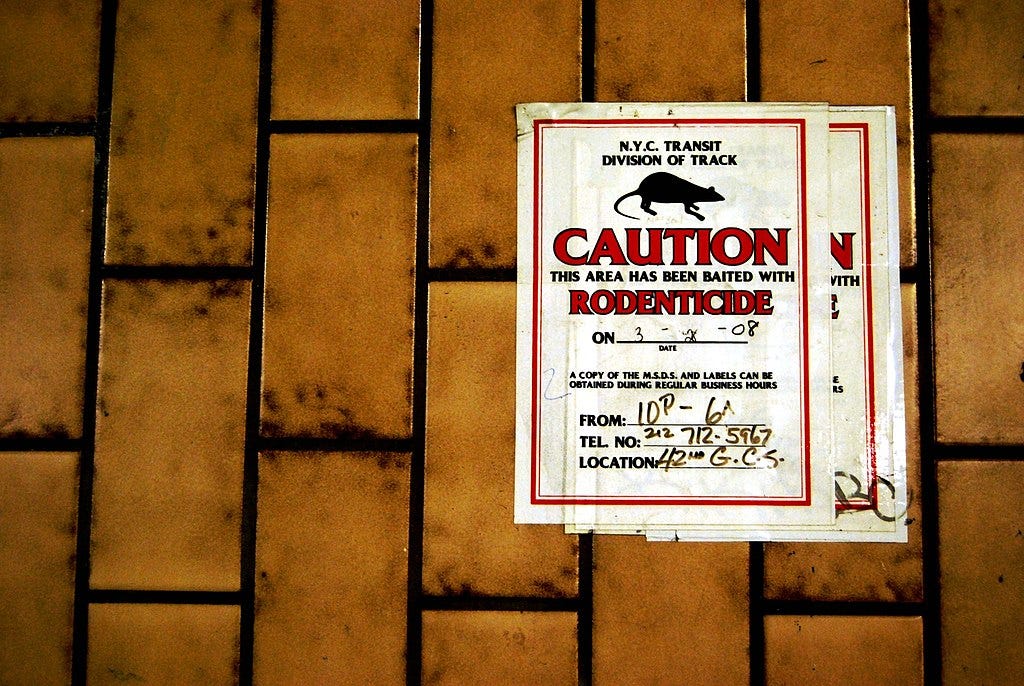I guess since we’re winning the war on drugs (fentanyl and other opioid overdose deaths are down so significantly and suddenly, scientists are scratching their heads) now it’s time to attend to the rats.
Hearing on NPR that there was a Rat Summit happening in NYC this week, had me lingering longer near the kitchen radio to wash more dishes I wasn’t intending to wash just yet. I mean, sure you don’t want nasty pests coming for your food residue, but also, rats are just fascinating. Note: the fact that I still listen to public radio on an actual radio is as old-school as these damn rats, neither of which are going anywhere. But Rat Summit, have at it.
These supposedly gross bottom feeders of the bowels of our global metropolises are more advanced than you think and way more prevalent than you want to imagine. A scientific study found them to be altruistic in their caring for each other, offering food to others in their tribe in need at a detriment to themselves—which sadly seems to be debunked in a more recent study. Better to remember: they can also give you a case of the old-timey plague. So this Rat Summit wasn’t akin to something at the U.N. where all the flags and ambassadors are meant to coexist in kindness. The city’s battle with rats is nothing new and is inextricably tied to its waste problem, but Mayor Eric Adams has made it his particular mission to eradicate this unwelcome if ever-lingering/escalating population at last, appointing a rat “czar,” and kicking off this first ever two-day summit of rat experts. From Gothamist:
“I don’t think there’s been a mayor in history that says how much he hates rats,” he said. “I dislike rats. And I am so happy I have a four-star general who is working on finally winning the war on rats.”
Studies also show people who find themselves spending more time with rats suffer more depression. They don’t mean by adopting a pet rat by choice or by vocation when you’re a naturalist who tracks them or the obsessive writer below who gathers their tales, but an unnatural alignment due to wretched housing conditions or the lack thereof. Hard to tease out in that scenario what depression-weight the rats themselves hold in that equation but I can see their presence would definitely make a dire situation much worse.
My Brooklyn rat encounters leaned toward the mummified versions I would find grotesquely preserved in the basement I was clearing out for my demented Stain Bar project, making way for kegs and wine case storage, and the tools my landlord’s goons would just steal from me freely. I lost count but I think in my early demo/reno days, I might have discovered about a dozen rat carcasses (carcae?) in the ancient 1890 crevices and cavities of the dropped ceiling, very grateful they were long dead and nicely taxidermied.
Giant living rats flit across the corners of your perception sometimes from dark warm piles of stinking summer trash bags on city curbs to the sewer grates or some odd crack that can’t possibly be big enough (alas—rat fact—it is always big enough: they can squeeze through spaces that don’t even exist and the way they file their ever-growing teeth is to bite through most anything). Like cockroaches and bedbugs, rats are a scary shadow species to us viral humans, mimicking our foulness while also reminding us to keep it in check. I haven’t seen any such species in my years since in Sleepy Hollow (upgraded to raccoons) but I’m sure they are out there—perhaps a beneficial factor of midlife and earlier bedtimes.
Once in my city days roaming the nocturnal hipster streets, I read RATS: Observations on the History and Habitat of the City’s Most Unwanted Inhabitants by Robert Sullivan.
Rats live in man’s parallel universe, surviving in the very cities where we do the same. If the presence of a grizzly bear is the indicator of the wildness of an area, the range of unsettled habitat, then a rat is an indicator of the presence of man. And yet, despite their situation, rats are ignored or destroyed but rarely studied, disparaged but never described.
From the book jacket:
Thoreau went to Walden Pond to live simply in the wild and contemplate his own place in the world by observing nature. Robert Sullivan went to a disused, garbage-filled little alley in lower Manhattan to contemplate the city and its lesser-known inhabitants—by observing the rat.
Rats live in the world precisely where humans do; they survive on the effluvia of human society; they eat our garbage. While dispensing gruesomely fascinating rat facts and strangely entertaining rat-stories—everyone has one, it turns out—Sullivan gets to know not just the beast but its friends and foes: the exterminators, the sanitation workers, the agitators and activists who have played their part in the centuries-old war between human city dweller and wild city rat. With a notebook and night-vision gear, he sits nightly in the streamlike flow of garbage and searches for fabled rat-kings, sets out to trap a rat, and eventually travels to the Midwest to learn about rats in Chicago, Milwaukee, and other cities of America. With tales of rat fights in the Gangs of New York era and stories of Harlem rent strike leaders who used rats to win tenants basic rights, Sullivan looks deeper and deeper into the largely unrecorded history of the city and its masses—its herd-of-rats-like mob. Funny, wise, sometimes disgusting but always compulsively readable, Rats earns its unlikely place alongside the great classics of nature writing.
Some rat facts gleaned from this book:
26% of all electric cable breaks and 18% of all phone cable disruptions are caused by rats.
25% of all fires of unknown origin are rat-caused.
Rats destroy an estimated 1/3 of the world’s food supply each year.
The rat has been called the world’s most destructive mammal—other than man.
Male and female rats are sex machines. They may have sex 20 times a day, and a male rat will have sex with as many females as possible. A female can produce up to 12 litters of 20 rats a year: one pair of rats has the potential for 15,000 descendants in a year.
Of the estimated 25-35 million animals used in research experiments in the US every year, about 95% are birds or rodents.
Rats cannot vomit.
And more from Gothamist and the experts at the Rat Summit:
NYC rats are fearless compared to their Canadian counterparts, said a scientist tracking them who has handled 700 of them herself, and like many finds New Yorkers to be rude.
Rats enjoy peeing on each other! “Rats don’t just like to live together. Experts say the fuzzy freaks also urinate on one another to assert dominance.”
Welcome the stranger? Can’t we all just get along? There is something of the mythology of the immigrant in this anti-rat ranting, the looming if mysterious threat of the invading other who if given a tiny access point will expand it into a black hole that absorbs all the food, all the jobs, all the money, all the resources, projected to paralyzing fearful effect by our presidential politicking of the moment and some unfortunate rumors hating on Haitian pet eaters.
From Sullivan:
Rats have conquered every continent that humans have conquered, mostly with the humans’ aid, and the not-so-epic-seeming story of rats is close to one version of the epic story of man: when they arrive as immigrants to a newfound land, rats push out the creatures that have preceded them, multiply to such an extent as to stretch resources to the limit, consume their way toward famine—a point at which they decline, until, once again, they are forced to fight, wander, or die.
In this scrappy, up-by-your-bootstraps country, you even get to fight for your right to work and at a fair wage. The ultimate symbol of worker unrest is this dreadful “Scabby,” the inflatable rat character, born in 1980s Chicago labor union disputes, and witnessed leaning against many a scaffolded edifice in my time in NYC since. A whole history of Scabby from AP News:
Although having a rat as a mascot seems quintessentially New York, Scabby the Rat was actually invented by a union in Chicago around the late 1980s (several claim credit), and other unions around the country quickly adopted the practice of using inflatables to draw attention to actions (pigs, roaches and cats are other popular inflatables to use as well, although they lack a catchy nickname).
There are many Scabbys. At another union action in March at a Petco, Marty Flash sat in the cab of his truck used to ferry one of the NYC District Council of Carpenters’ eight rats around (most unions have several, or borrow from unions that do). Most of the District Council’s rats, along with a generator and gas can, stay in a locker at union headquarters or in organizers’ trucks so they can be quickly deployed.
Flash, a carpenter for 35 years, has seen many reactions to the 10-foot-tall (3-meter-tall) rat, which, at the moment, was towering over Union Square in the truck’s bed.
“In midtown Manhattan, it’s a tourist attraction. Little children get a real kick out of it. They come over, they want to touch it. Dogs are petrified of it,” he said. Flash said Scabby can inflate in about a minute and a half with a generator and deflate in about 30 seconds. Bigger rats— the rats range from 8 to 20-plus feet (more than 6 meters)—can take 15 minutes to fill up.
Scabby’s name is a play on “scabs,” the derogatory term dating back to the 1800s for strikebreakers who cross picket lines to work. The oozing sores on his belly are a visual reference to the term. But Flash said workers at the sites visited by Scabby shouldn’t take offense, since the rat is protesting against contractors and companies, not the workers themselves.
Inflatable or not, rats have this rep for being down and dirty, the sort of thing that “rats” you out. In popular culture, the most famous tie to this idea of rat as traitor or snitch comes in an oft-quoted quote from the 1931 movie Taxi with James Cagney, when his character says to his brother’s killer, through the closed closet door:
“Come out and take it, you dirty, yellow-bellied rat, or I’ll give it to you through the door!”
Slate.com has a whole etymology on rat slang from its denigrating connection as far back as the 16th century or sooner to cheaters, drunkards and pirates, to its more recent (19th century) usage as an informant, tattletale, snitch. To which, Mayor Adams would likely say, frankly my dear,
“I don’t give a rat’s ass.”







Rats, I meant to comment earlier!
Just kidding, but I did get to make a rat dad-joke. Worth it.
Twice I've been in an apt and had rats, neither in NYC. In the city I always feel back home when I see a rat in the subway. I kind of like rats, but not in my apt. (P.S. Twenty times a day??)